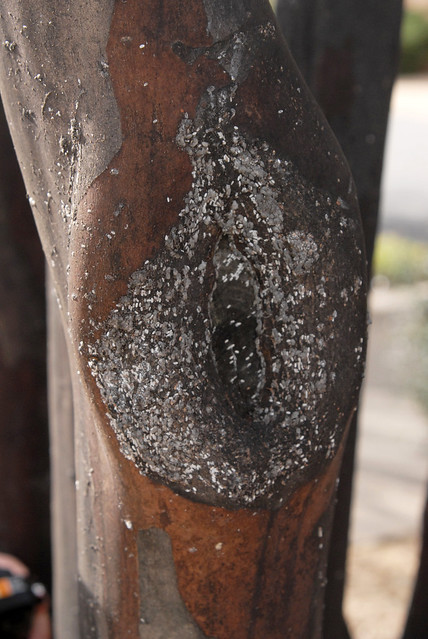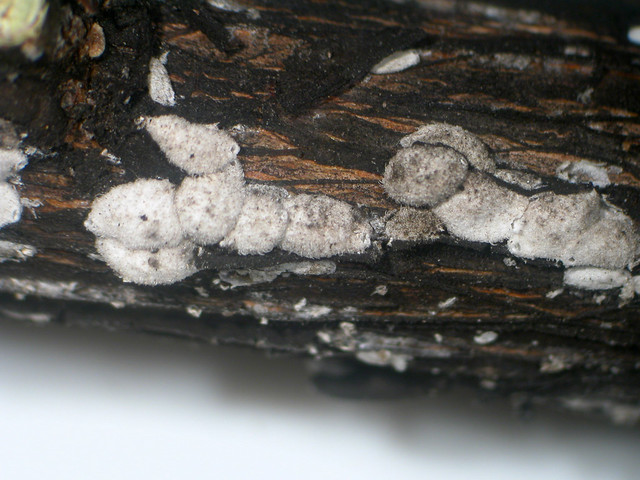Imported pest of crape myrtles spotted in Little Rock, Memphis
Fast Facts
- Crape myrtle bark scale first spotted in Dallas suburbs in 2004
- Spotted in Little Rock, Memphis, Tenn.-area, in January 2014
- In Feb., ask your county office for "Crapemyrtle Bark Scale: a new insect pest." FSA7086, or find online at www.uaex.uada.edu.
LITTLE ROCK – About a decade after being first spotted in Texas, an imported pest of crape myrtles has been found in Arkansas, extension entomologists for the University of Arkansas System Division of Agriculture said.
An import from Asia, the crape myrtle bark scale insect lives off plant sap. In large enough numbers, they can be fatal to the plant.
In 2004, they were first spotted in suburbs north of Dallas.
“Since being spotted in McKinney, Texas, in 2005 -- a city that bills itself as ‘America’s Crape Myrtle City’ -- the crape myrtle bark scale has been spreading at an alarming rate,” said Jim Robbins, professor and extension horticulture specialist-Ornamentals, for the Division of Agriculture. “In 2012, it was spotted in northern Louisiana in Shreveport and last year in Houma, in the southern part of the state.”
The insect has also been confirmed in the Memphis, Tenn., area in Germantown.
Robbins said there’s heightened concern about the spread of this insect, considering the popularity of crape myrtles in landscapes across the U.S. Researchers in Arkansas and Texas are working to determine what cultivars might be vulnerable to this insect, and find solid control methods.
Fortunately, crape myrtle bark scale is easy to identify, since it’s the first and only known bark scale to occur on crape myrtles. Adult females look like white or gray felt encrustations and each is about 2 mm in length. Under the gray felt covers, gardeners may discover dozens of pink eggs or crawlers.
UP CLOSE -- These felted scales that are the hallmark of the crape myrtle scale bark insect, found in January 2014 in Little Rock and Germantown, Tenn. It was first reported in the U.S. in the Dallas area in 2004. (U of Arkansas System Division of Agriculture photo by Jim Robbins)
“Based on our experience so far, this insect is not going to be easy to control,” said John Hopkins, extension urban entomologist for the University of Arkansas System Division of Agriculture. Current best practices include:
For heavily infested plants wash the trunk and reachable limbs with a soft brush and mild solution of dishwashing soap. This will remove many of the female scales and egg masses and make insecticide control more effective. Also, washing will remove much of the black mold that builds up on the bark on infested trees.
Horticultural oil has not yet been shown to be effective against this insect, however a winter application of dormant oil to the bark and crotches of the plants where scales shelter may be beneficial. Be sure to use sufficient volume to allow for penetration behind loose bark and into cracks and crevices. Winter is an especially good time to treat for scales because a higher -- winter -- application rate can be used without damaging the plant. Thorough coverage of the tree is especially important when treating with oil.
Application of systemic insecticides as a drench applied to the root zone has shown the most promise in tests to date. Imidacloprid, available as Merit® or Bayer Advanced™ Garden Tree and Shrub Insect Control; thiamethoxam, known as Meridian®, and dinotefuran, known as Greenlight Tree and Shrub Insect Control with Safari; have shown best control when applied between May and July. When drenching the soil with a systemic insecticide, allow several weeks for the product to be distributed throughout the plant. Additionally, acetamiprid and clothianidin, also neonicotinoids, have demonstrated good control.
Certain insect growth regulators are recommended for scale control in woody ornamentals but haven’t been evaluated on the crape myrtle bark scale.
Lady beetles should be protected as the twice-stabbed lady beetle is an efficient predator of this scale.
Both Robbins and Hopkins advise notifying your location Cooperative Extension Service office or state Plant Board if you notice symptoms of scale insect infestation on your crape myrtles in Arkansas.
Robbins, Hopkins and Mike Merchant, professor and extension urban entomologist for
Texas A&M AgriLife Extension Service, will have a fact sheet available in February
on the pest called “Crapemyrtle Bark Scale: a new insect pest.” Ask your county extension
office for FSA7086 or find it online at www.uaex.uada.edu.
For more information about integrated pest control, horticulture and other programs of the University of Arkansas Cooperative Extension Service, contact your county extension office or visit www.uaex.uada.edu. Please note that many links to extension publications will be changing this spring as the extension service renovates its site.
Pursuant to 7 CFR § 15.3, the University of Arkansas System Division of Agriculture offers all its Extension and Research programs and services (including employment) without regard to race, color, sex, national origin, religion, age, disability, marital or veteran status, genetic information, sexual preference, pregnancy or any other legally protected status, and is an equal opportunity institution.
January 14, 2014
By Mary Hightower
U of A System Division of Agriculture
Media Contact: Mary Hightower
Extension Communications Specialist
U of A Division of Agriculture
Cooperative Extension Service
(501) 671-2126
mhightower@uada.edu
Related Links

